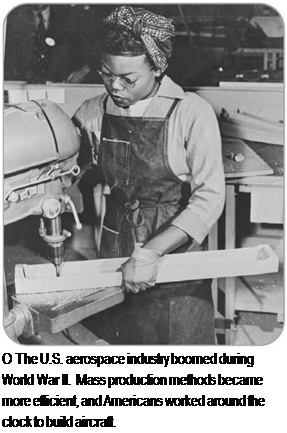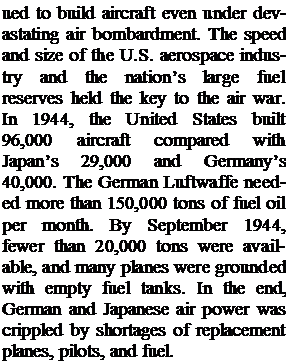Industrial Production
Prewar theories that bombing would destroy civilian morale and halt factory production proved inaccurate. The British did not crumble during the Blitz; the Russians moved their factories east out of range of German planes; and German and Japanese workers contin-

![]()
 WORLD WAR II AVIATION ADVANCES
WORLD WAR II AVIATION ADVANCES
World War II was a war of air power. During the course of the war, top speeds of fighter aircraft rose from about 350 to 450 miles per hour (563 to 724 kilometers per hour). Bombers flew higher to escape interception: up to 35,000 feet (10,700 meters) by 1945. Naval battles among ships were replaced by long-range air battles between planes flying from aircraft carriers. Factory production methods speeded up manufacture, and technology greatly improved the range, navigation, gun power, and bombing accuracy of warplanes. Air transports, such as the C-47 and C-54, carried troops and supplies, and parachutes were used to land them. Radar was the key air invention: It aided ground defenses and also helped pilots locate enemy targets. Air weapons became more destructive as bombs laid waste to cities, and guns and rockets could blow planes apart in midair. For protection, planes had armor plating and self-sealing fuel tanks. By 1944 to 1945, air warfare had been changed forever by new weapons and technology: jet planes, helicopters, the V-1 flying bomb, the V-2 missile, and the atomic bomb.
_____________________________________________________ /
N
SEE ALSO:
|
• Aircraft, Military • Aircraft Carrier • Bomber • Fighter Plane • Missile • Parachute • Radar
|
![]()










